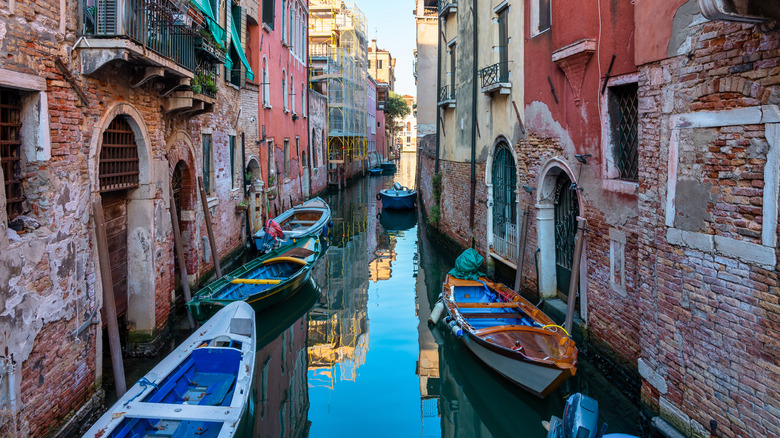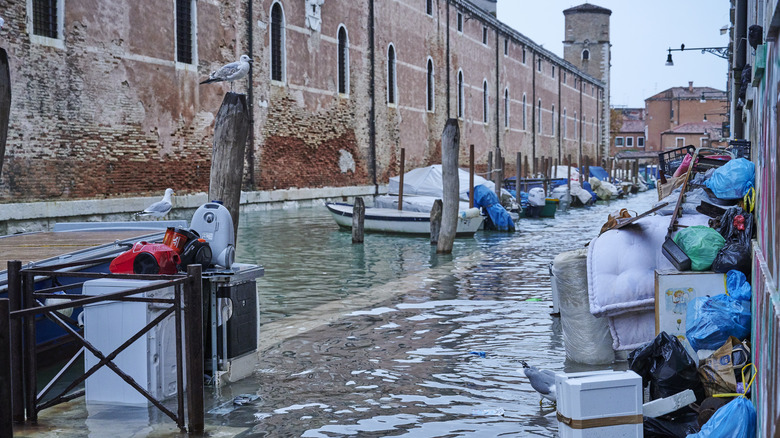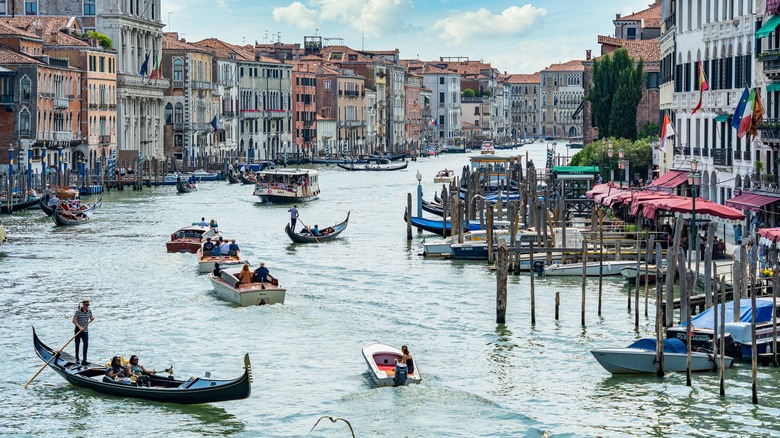Disturbing Reasons Why Swimming In Venice's Canals Is Illegal
A city where the roads are waterways and the cars are gondolas — Venice is a place you have to experience to believe. Founded in the fifth century, this ancient city is a marvel of human ingenuity floating on 118 small islands, and visited by around 20 million people every year. Venice also gets hot in the summertime, hitting 82 degrees in July. Combine the sizzle with being in the inferno of tourist crowds, and jumping into those azure canals for a dip can sound quite refreshing. However, this is strictly prohibited. The reasons behind this are not just bureaucratic or for the sake of tradition. They are deeply rooted in concerns for health, safety, and the preservation of the city's unique ecosystem and heritage as a UNESCO site.
Ecco due imbecilli prepotenti che si fanno beffa della Città... chiedo a tutti di aiutarci a individuarli per punirli anche se le nostre armi sono davvero spuntate... servono urgentemente più poteri ai Sindaci in tema di sicurezza pubblica!
A chi li individua offro una cena! pic.twitter.com/DV2ONO3hUs— Luigi Brugnaro (@LuigiBrugnaro) August 17, 2022
Swimming in Venice's canals is, first and foremost, illegal. Police will fine anyone found guilty at least 500 euros ($540), and they may even kick them out of the city. Two tourists in 2019 decided to skinny dip in a canal near the Piazza San Marco and were swiftly fined $3,320 (after they put their clothes on, of course). In 2022, two surfers thought it would be a good idea to catch some "waves" along the Grand Canal. Once they got caught, both were fined 1,500 euros each (over $1,600), their boards (worth 25,000 euros) were confiscated, and they were expelled from the city. The mayor of Venice, Luigi Brugnaro, called them "two arrogant imbeciles making a mockery of the city." Sounds about right.
Health hazards
Even though it's clearly illegal, more than 40 tourists were arrested during 2022 for swimming, skinny dipping, and even jumping into Venice's lagoon. In 2023, a man wearing boxer shorts jumped off a three-story building and belly-flopped into a canal, with his accomplice filming the stunt for social media. What that man probably didn't know is that Venice's 150 canals are part of the city's sewage and waste management system. That's right, he and many others are dipping in some trash water.
Venice lacks a modern sewage treatment infrastructure because of the way it was initially constructed atop the lagoon. In order to implement a proper sewage system with pipes and conduits, the entire city would have to be literally raised by almost two feet — an impossible undertaking. While significant improvements have been made — such as implementing more modern septic-tank systems — untreated sewage still finds its way into the canals, especially during heavy rain when the system is overwhelmed. Additionally, the canals are heavily contaminated with fuel and oil from boats.
The combination of human waste, industrial pollutants from chemical plants located in the nearby Porto Marghera, and debris (including old tires and pigeon poop!) creates a breeding ground for harmful bacteria. Around 90% of all human waste produced in Venice ends up in the canals, and they are only cleaned once every ten years. Swimmers risk contracting gastroenteritis, skin rashes, and other more severe diseases. Even though the water may look clear, it still contains toxic substances.
Water traffic and cultural concerns
Venice's canals are bustling with various forms of water traffic, including vaporettos, gondolas, water taxis, and private boats. These waterways function like streets in a typical city, and the congestion can be intense, especially during peak tourist seasons. Swimming among this chaotic flow is not just impractical, it's extremely dangerous, and accidents could easily result in serious injury or death. The operators of these vessels often have limited visibility, and the narrow, winding nature of many canals makes it difficult to spot a swimmer in the water. The currents and wake patterns in some canals make it easy for swimmers to be swept into the path of oncoming boats.
Swimming in the canals is also considered disrespectful. Venetians take great pride in their city and its unique heritage, and activities that endanger or degrade this heritage are met with extreme disapproval, especially amid a trend of tourists doing the most horrific things in Italy. Tourists and residents alike are expected to adhere to local customs and regulations, demonstrating respect for the city's history and the well-being of its inhabitants. Although swimming in Venice's canals was historically common and even considered healthy — with public bath houses and swimming competitions happening well into the 20th century — changes in water quality, increased boat traffic, and pollution have made it unsafe. Instead of swimming, there are plenty of other ways to enjoy the beauty of Venice, such as a serene gondola ride or a stroll along its historic streets.


